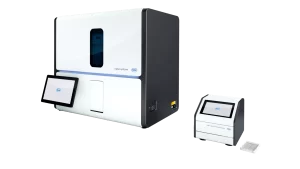Home » Medical and Laboratory equipments Products cost » Mutation Detection – Digital LightCycler® System
Mutation Detection – Oncology
The Roche Digital LightCycler® System represents a significant leap forward in digital PCR technology. As the digital PCR instrument of tomorrow, it offers a unique combination of three nanowell plate configurations, six advanced optical channels, and 5x concentrated DNA and RNA master mixes. This powerful system has the potential to help your lab move from publishing research to producing clinically viable assays.
|
Mutation Detection – Oncology
Key Features:
- Semi-Automated Workflow: The Digital LightCycler® System supports a semi-automated workflow to run Polymerase Chain Reaction (PCR) based Nucleic Acid Testing (NAT).
- Digital Endpoint PCR Analysis: The system performs digital endpoint PCR analysis of microfluidic partitions, combining the functionalities of instrumentation, consumables, reagents, and data management for efficient workflow from sample partitioning to result interpretation.
- Intended Use: Designed for in vitro diagnostic use by professional users in diagnostic and screening laboratories.
- System Components: The system consists of the Digital LightCycler® Analyzer, the Digital LightCycler® Partitioning Engine, and specified consumables, core reagents, and application software. All assays are developed independently of the Digital LightCycler® System.
- Digital PCR Technology (dPCR): The system uses dPCR technology for absolute quantification of nucleic acid target copy number without a standard curve.
- Advanced Applications: The system allows for a wide range of applications, such as oncology by analyzing cell-free DNA, rare mutations, copy number variations, and gene expression, or infectious disease diagnostics by detecting and quantifying low viral loads.
- Main Features:
- Digital PCR technology for low target detection.
- Six fluorescence channels for multichannel detection.
- Three analysis types (absolute quantification, CNV, indel).
- Workflows for diagnostic and development purposes.
- Development software for detailed data analysis.
- 5x concentrated DNA and RNA master reagents for higher sample fraction.
- Partitioning of each sample into a large number of nanowells on a dedicated nanowell plate.
- Merged lanes emulate the partitioning of a larger sample volume into an even higher number of nanowells.
- Three types of nanowell plates (universal, high resolution, high sensitivity) for different applications.
- Partitioning of up to eight samples on one nanowell plate in the partitioning engine.
- Processing of up to 96 samples on 12 nanowell plates on the analyzer.

